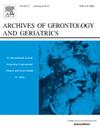Understanding physical aging in relation to biological aging, telomere length: A systematic review
IF 3.5
3区 医学
Q2 GERIATRICS & GERONTOLOGY
引用次数: 0
Abstract
Background
Telomere length (TL) serves as a marker for biological aging, influenced by chronological aging but distinct from it. This systematic review aims to synthesize the evidence on the associations between components of physical aging and TL in the elderly population.
Methods
A comprehensive search was conducted in online databases of PubMed, Web of Science, ProQuest, and ScienceDirect to identify the eligible papers published until 1st August 2024. The authors independently extracted data using the standardized form. The quality of the included studies was evaluated for the risks of biases.
Results
A total of 1080 records were initially identified using the predefined search strategy. A total of 40 eligible records were included in this review. When assessing physical aging, the nature and type of measurements across studies vary, including subjective, objective, and a combination of both approaches. Subjective assessments of general health or physical limitations may be linked with TL, while frailty, whether measured subjectively or objectively, shows associations with TL in less than 35 percent of total studies. In contrast, composite measures of physical performance/ability are consistently associated with TL in the elderly population.
Conclusions
In conclusion, we demonstrated that the associations between physical aging and TL varies depending on the type and nature of physical aging assessments. Composite measures of physical performance/ability demonstrate a strong and consistent parameter of physical aging to link with TL. Future research should prioritize standardized, multidimensional approaches to measure physical aging to understand better its association with TL to support healthy aging strategies.
了解物理老化与生物老化、端粒长度的关系:一项系统综述
端粒长度(TL)作为生物衰老的标志,受时间衰老的影响,但与时间衰老不同。本系统综述旨在综合老年人群生理老化成分与TL之间关系的证据。方法综合检索PubMed、Web of Science、ProQuest、ScienceDirect等在线数据库,筛选出2024年8月1日前发表的符合条件的论文。作者使用标准化表格独立提取数据。对纳入研究的质量进行偏倚风险评估。结果使用预定义的搜索策略,总共识别了1080条记录。本次评审共纳入了40份符合条件的记录。在评估身体衰老时,研究中测量的性质和类型各不相同,包括主观的、客观的以及两种方法的结合。一般健康或身体限制的主观评估可能与TL有关,而虚弱,无论是主观还是客观地衡量,在全部研究中显示与TL有关的比例不到35%。相反,身体表现/能力的综合测量与老年人群的TL一致相关。结论身体衰老与TL之间的关系取决于身体衰老评估的类型和性质。未来的研究应优先考虑标准化、多维度的生理衰老测量方法,以更好地了解其与生理衰老的关系,从而为健康老龄化策略提供支持。
本文章由计算机程序翻译,如有差异,请以英文原文为准。
求助全文
约1分钟内获得全文
求助全文
来源期刊
CiteScore
7.30
自引率
5.00%
发文量
198
审稿时长
16 days
期刊介绍:
Archives of Gerontology and Geriatrics provides a medium for the publication of papers from the fields of experimental gerontology and clinical and social geriatrics. The principal aim of the journal is to facilitate the exchange of information between specialists in these three fields of gerontological research. Experimental papers dealing with the basic mechanisms of aging at molecular, cellular, tissue or organ levels will be published.
Clinical papers will be accepted if they provide sufficiently new information or are of fundamental importance for the knowledge of human aging. Purely descriptive clinical papers will be accepted only if the results permit further interpretation. Papers dealing with anti-aging pharmacological preparations in humans are welcome. Papers on the social aspects of geriatrics will be accepted if they are of general interest regarding the epidemiology of aging and the efficiency and working methods of the social organizations for the health care of the elderly.

 求助内容:
求助内容: 应助结果提醒方式:
应助结果提醒方式:


